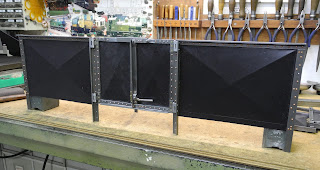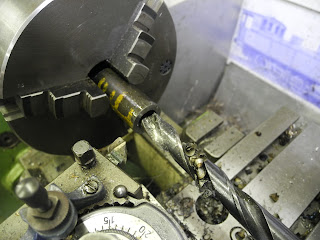The Klappdeckelwagen (lidded wagon) has its name from the 'Deckels' (lids or top doors) that cover the top of the wagon. Six lids are to be hinged at a central beam on the top of the wagon.
They can be opened, but only in a certain order. First, the middle one has to be lifted, and then the right or left ones can be opened. This is due to the rain gutters that are attached to these lids.
Because the goods (chalk, zinc ore, salt, and such) had to be transported protected from the weather, the lids were designed with rain gutters. For the model of this wagon, this is not really necessary, but I thought it would be nice to try to make these gutters.
The lids themselves are made from 0.8 mm steel plate (recycled from an old Ikea wardrobe) and are bent the same way as the side walls and doors made previously.
First, some work on the end plates had to be done.
Riveting the support beams on the end plates.
This gives these plates their rigidity.
Drilling in the buffer beam, for fixing the support beams to the frame.
The U-shaped top beam is made by sawing a 25 x 25 mm. square tube in half.
Milling the top beam to size. The workpiece had to shift several times in the vice.
Two angle plates secure the top beam to the end plates.
With a special narrow bending die, the top side plates are bent.
Due to two bends in opposite directions, this narrow bottom die was needed. (This is a homemade die.)
The top side plates are in position.
The lid plates are cut to size and scribed.
After the first bend over one long diagonal (220 mm), the second and third bends are made separately over half the diagonal (110mm). The top dies are set up to the according to length.
With a front-end stop, the rain gutter is bent. Several small bends give the round shape.
The front stop is moved each time a few millimeters.
Drilled and the ends cut to size, ready for riveting on the lids.
The gutter. Two rivets will be placed later on; they will be used to hold the door handles as well.
The rain gutter on the right, is seen from the underside.
A jig for drilling the holes for the top gutter. A lot of rivets will be used. 😄.
The jig is one of the side profiles. Although I thought I have taken the greatest care to make them in pairs (left, right), I still made a mistake: it was mirrored. 😕
A first test fitting (hold in position with some magnets).
Because I have bent the plate (and not deformed it with a deep drawing process), there is a deflection/deformation on the sides. The side profiles and gutters bring them back in shape.
The next thing to do is to make the hinges.
The Solidworks drawing with more details added.











































































